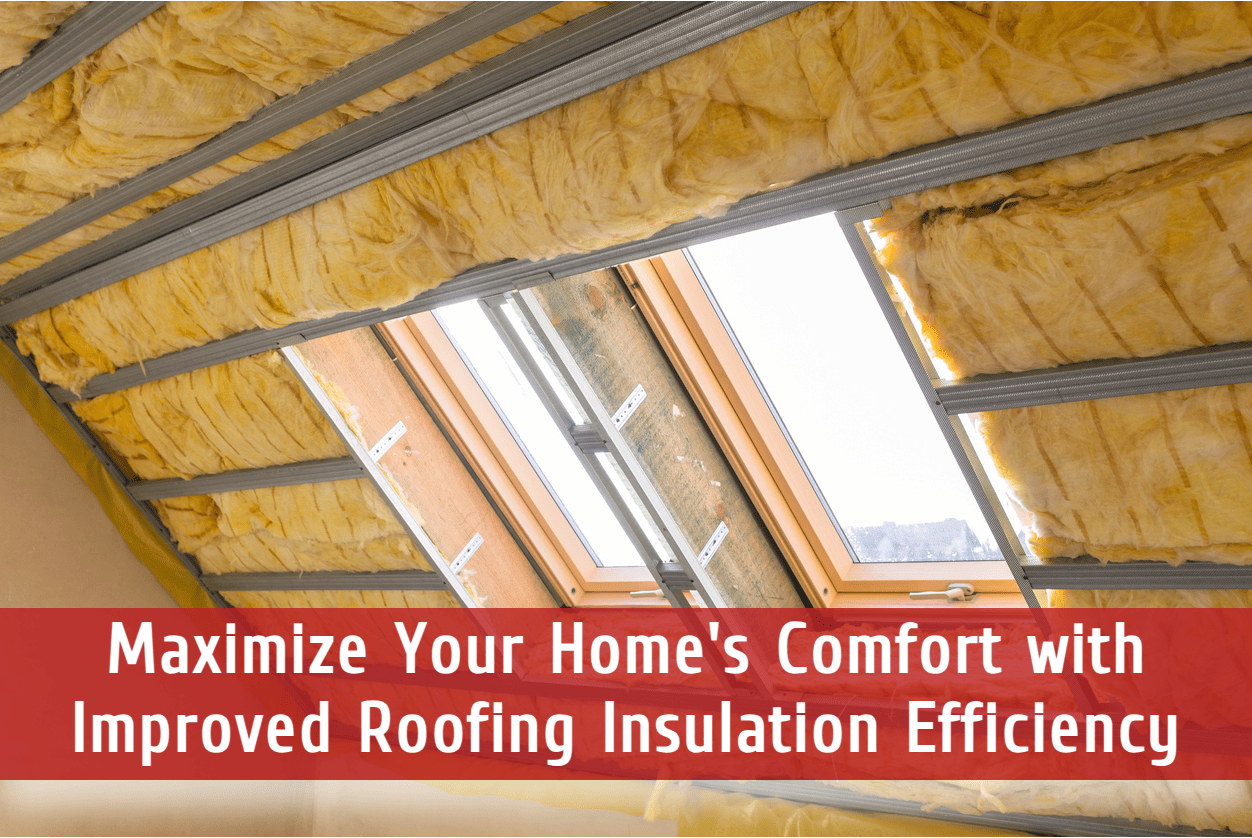Improving your home’s energy conservation starts with enhancing your roofing insulation efficiency. In Wisconsin’s diverse climate, keeping your home comfortable year-round can be a challenge. Roofing insulation plays a pivotal role in this, acting as a barrier that slows the movement of heat, helping to keep your home warm in the winter and cool in the summer. Understanding the types of roofing insulation available is the first step towards a more energy-efficient home.
The benefits of attic insulation are numerous, including reduced energy bills and a more consistent indoor temperature. Choosing the right roof insulation methods and energy-efficient roofing materials can significantly impact your home’s energy usage. For instance, selecting materials with a high R-values ensures greater thermal resistance, and ultimately, better insulation performance. Whether you’re building a new home or upgrading your current residence, prioritizing roofing insulation efficiency can lead to substantial savings and enhanced comfort for years to come.
Exploring the Types of Roofing Insulation Available
When considering roofing insulation efficiency, there are several types of materials to choose from, each with unique properties and benefits. One of the most common types of roofing insulation is fiberglass batts, which are easy to install and cost-effective. Another popular option is cellulose insulation, which is made from recycled paper and is treated for fire-resistance.
Spray foam insulation is a versatile choice that easily fills in gaps and cracks, providing an airtight seal. It’s particularly effective for attic insulation as it can easily conform to the space it’s applied to. For those looking for sustainable options, rigid foam insulation is durable, recyclable, and has a high R-value, making it an excellent choice for most homes.
Each type of insulation comes with its own installation methods. Understanding these options and their respective insulation R-value for roofs can guide homeowners and roofing contractors in Wisconsin to make informed decisions that yield the best energy savings and comfort levels.
The Impact of Attic Insulation on Energy Costs and the Comfort of Your Home
Paying attention to roofing insulation efficiency can result in significant savings on energy bills for Wisconsin homeowners. Proper attic insulation acts as a thermal shield, reducing the demand on heating and cooling systems. During the frigid winters, insulation retains the heat within the home, minimizing the workload of the furnace. Similarly, in the summer, it prevents the hot air from infiltrating living spaces, keeping the interior cool and reducing air conditioning costs.
The right insulation R-value is crucial for achieving these benefits. R-value measures the insulation’s ability to resist heat flow, with higher values indicating better performance. Wisconsin’s climate necessitates a careful selection of R-values to ensure optimal thermal efficiency. By consulting with a knowledgeable roofing contractor, homeowners can determine the appropriate R-value needed for their specific location and housing type.
Beyond just energy savings, benefits of attic insulation extend to overall comfort. A well-insulated home maintains a stable temperature, eliminating cold drafts and hot spots. This creates a more enjoyable and comfortable living environment, contributing to the well-being of the residents. Roofing contractors in Wisconsin understand the local weather patterns and can guide homeowners in selecting and installing the best energy-efficient roofing materials and insulation that will provide comfort throughout the seasons.
Understanding Insulation R-value and Its Importance
When it comes to optimizing the energy efficiency of your home, one number stands out: the insulation R-value. This numerical rating is crucial for homeowners to understand, as it directly correlates to the insulation’s thermal resistance capability. In the cold winters and warm summers of Wisconsin, a roofing system with a proper R-value can make a significant difference in comfort and energy conservation.
To achieve the highest roofing insulation efficiency, it’s essential to select an R-value that aligns with Wisconsin’s climate demands. The Department of Energy recommends varying R-values based on geographic location and the part of the home being insulated. For instance, attics in Wisconsin typically require a higher R-value due to the propensity for heat to rise and escape through the roof.
Roofing contractors in Wisconsin can conduct energy audits and assess current insulation levels, helping homeowners understand where improvements can be made. By installing insulation with the correct R-value, not only will the indoor temperatures be more stable, but homeowners can also see a reduction in heating and cooling costs. Choosing the right roofing insulation efficiency strategy, including the ideal R-value, is a smart investment that pays off in both the short and long term.
Customized Roof Insulation Methods for Enhanced Efficiency
Choosing the most effective roof insulation methods is essential for achieving high roofing insulation efficiency in Wisconsin homes. Each home is unique, and requires a tailored approach to insulation that considers factors such as the home’s design, the local climate, and the homeowner’s budget. Blown-in insulation, for example, is ideal for attics with irregular joist spacing or numerous obstructions, as it provides complete coverage and fills hard-to-reach areas.
For homes with ample attic space, installing rigid foam boards beneath the rafters can serve as an excellent barrier against heat transfer. Another efficient approach is to combine different types of roofing insulation in layers to achieve a higher cumulative R-value and seal air leaks effectively. This method capitalizes on the strengths of each material, such as the airtight seal of spray foam coupled with the affordability of fiberglass batts.
Wisconsin homeowners should also consider the installation process when selecting roof insulation methods. Professional roofing contractors can assess the specific needs of a home and recommend the best techniques and materials. They ensure that the energy-efficient roofing materials are installed correctly, which is critical for maximizing the insulation R-value for roofs and extending the lifespan of the insulation. By partnering with experienced contractors, residents can enjoy a more comfortable home environment while reducing energy consumption.
The Role of Roofing Insulation in Reducing Your Carbon Footprint
Adopting roofing insulation efficiency is not only about enhancing home comfort and reducing energy bills, it’s also about taking a step towards environmental responsibility. Efficient roofing insulation significantly lowers energy consumption, which in turn reduces the carbon footprint of a household. The use of energy-efficient roofing materials and proper roof insulation methods can lead to a substantial decrease in greenhouse gas emissions associated with heating and cooling.
For environmentally conscious homeowners, selecting types of roofing insulation such as recycled cellulose or rigid foam can contribute further to eco-friendly building practices. By working with a roofing contractor who specializes in energy-efficient solutions, Wisconsin residents can ensure that their roofing choices support a healthier planet.
Every small change contributes to a larger impact, and by improving roofing insulation efficiency, homeowners take an active role in combating climate change. Sustainable living begins at home, and it starts with the roof over your head. Choosing the right insulation is not just a personal benefit—it’s a collective step towards a greener future for all.
Step-by-Step Guide to Installing Roof Insulation
Properly installing roofing insulation is crucial for maximizing efficiency and ensuring the longevity of the material. The installation process begins with a thorough inspection of the attic space to identify any existing issues such as moisture, which could compromise the effectiveness of the insulation. Next, homeowners should ensure that the attic is properly ventilated to prevent heat and moisture buildup that can lead to mold growth and material deterioration.
Once the attic is prepped, the installation process varies depending on the types of roofing insulation chosen. If installing batts or rolls, they must be cut to fit snugly between joists without compressing the material, as this can reduce its effectiveness. For blown-in insulation, a specialized machine is used to evenly distribute the material across the attic floor, paying special attention to spaces around joists and rafters to prevent thermal bridging.
For optimal roofing insulation efficiency, sealing gaps and cracks with caulk or foam before insulation can prevent air leaks. It’s also essential to insulate attic access doors and hatch covers to maintain a continuous thermal barrier. Finally, after the insulation is installed, it’s important to check for any areas that may have been missed or need additional coverage to ensure a uniform layer that provides the best possible energy efficiency for the home.
Avoiding Common Roof Insulation Mistakes for Enhanced Efficiency
Ensuring optimal roofing insulation efficiency involves not just choosing the right materials but also avoiding common mistakes. One frequent error is inadequate sealing, where small gaps are left unattended, leading to significant heat loss. Homeowners should pay careful attention to sealing around fixtures, chimneys, and attic hatches to maintain a consistent thermal barrier.
Another oversight is uneven insulation distribution, particularly with blown-in types, which can result in cold spots and reduced efficiency. It’s crucial to achieve a uniform layer across the entire attic floor. Overlooking the need for proper ventilation is also a common pitfall, as it can cause moisture issues that compromise insulation integrity and roof structure. Sufficient ventilation ensures longevity for both the roofing materials and the insulation.
Neglecting the impact of thermal bridging, where heat bypasses the insulation through materials like wood or metal, can also diminish roofing insulation efficiency. To prevent this, continuous insulation across all structural elements is essential. By being aware of and addressing these common mistakes, Wisconsin homeowners can significantly improve the performance of their roofing insulation and enjoy a more comfortable and energy-efficient home.
Choosing Energy-Efficient Roofing Materials for Harsh Climates
Selecting the right energy-efficient roofing materials is particularly important for homeowners in harsh climates, such as those in Wisconsin. The extreme temperatures demand materials that not only provide energy-efficiency but also withstand the rigors of ice, snow, and intense sun exposure without compromising on thermal performance.
Metal roofs, for instance, are known for their durability and ability to reflect solar radiation, which is beneficial during the summer months. They can also be installed with an integrated layer of rigid foam insulation to enhance its efficiency. For those in areas prone to heavy snowfall, slate or ceramic tiles can help to prevent snow accumulation while also providing excellent insulation.
When considering roofing insulation, it is also vital to account for materials that offer moisture resistance and can prevent ice dams, which are common in Wisconsin winters. Properly sealed and insulated roofing systems prevent warm air from escaping through the roof, reducing the likelihood of ice dam formation. By carefully choosing materials that suit the specific climate challenges of Wisconsin, homeowners can ensure their roofing system offers maximum efficiency and protection throughout the year.
Roofing Insulation Efficiency in Wisconsin: Upgrade Your Home Today!
Ready to maximize your home’s comfort and energy efficiency? ReNew Roofing specializes in expert roofing insulation solutions tailored for Wisconsin homes. Our team is dedicated to helping you achieve optimal insulation efficiency, reducing energy loss, and lowering your carbon footprint. Take the next step towards a more comfortable and eco-friendly home. Call ReNew Roofing at (833) 715-7663 for a consultation and start enjoying the benefits of superior roofing insulation today.






